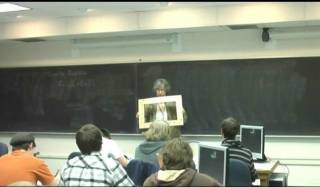Lorentz Force and Work Done on a Rectangular Loop
Highlights of the activity
- Students are placed into small groups and asked to calculate the force on a rectangular loop of current-carrying wire due to an external magnetic field.
- After finding a general expression for the force, the groups must then calculate the amount of energy needed to rotate the loop 90 degrees.
Reasons to spend class time on the activity
- Having students calculate the force on a current-carrying rectangular loop due to an external field also provides a good transition point into a discussion on the magnetic dipole moment.
- Students can then be shown the difference between the classically expected and measured results in the Stern-Gerlach experiment, which indicate the directions of the magnetic moment are quantized. Performing this activity before discussing the Stern-Gerlach Experiment will help provide some context for why the silver atoms originally used were forced either up or down relative to the device's orientation.
- This activity also requires them to pull together things that they learned in their introductory courses, as well as the early paradigms.
